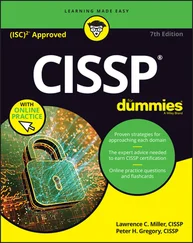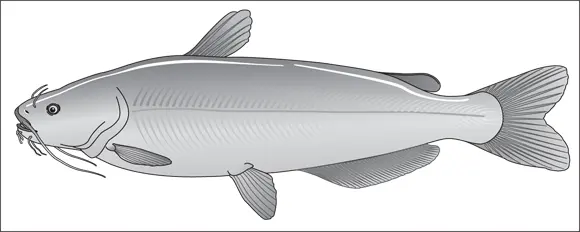
© John Wiley & Sons, Inc.
FIGURE 4-3:Notice the broad, muscled body of the blue catfish, which is built for big water.
Flathead catfish: Denizens of the deep lair
Similar to the blue catfish, flathead cats can weigh more than 100 pounds, and they also thrive in America’s big rivers, reservoirs, and lakes. However, flatheads tolerate muddier, slower water better than blues, and can be found in some surprising small streams. Flathead catfish feed on crustaceans and small minnows while young, but adults subsist on a diet of primarily fish (some of them quite large!). Although anglers occasionally catch flatheads on nightcrawlers or cutbait, most foraging flatheads prefer a struggling, live-hooked baitfish. Flatheads are most likely to be caught at night, when they leave the logjams and rock piles they take shelter around during the day. Flatheads live in nasty environs and have an attitude to match. Anglers targeting them use heavy tackle (think 80-pound braided line) and expect to horse them out of gnarly cover. Figure 4-4 shows a flathead catfish.
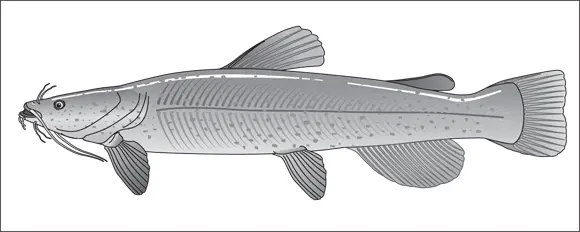
© John Wiley & Sons, Inc.
FIGURE 4-4:The flathead catfish is all mouth.
Channel catfish: Prince of the pond
Channel catfish taste great, which is why they’re raised on fish farms throughout the South. When you order “farm-raised catfish,” you’re getting channel catfish on your plate. But channel cats make great quarry for all anglers. They hit hard and fight long, and will outpull almost all fish of similar size. An extremely adaptive fish, channel cats can be found in everything from the largest rivers to the smallest ponds. They feed on everything from fish to insects, and grow quickly as a result. They can be caught on prepared stinkbaits, grocery store baits such as cheese and hot dogs, and natural baits like nightcrawlers and minnows. (Sometimes, anglers catch them on lures meant for bass or walleye.) They will hit night or day, and when in rivers or streams, can be found feeding in surprisingly swift current. Channel catfish (see Figure 4-5) are not as big as their blue and flathead cousins, but a channel of more than 20 pounds is possible, and it will fight like nothing else.
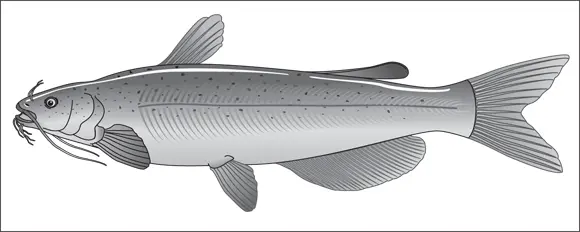
© John Wiley & Sons, Inc.
FIGURE 4-5:The adaptive channel cat is one of the most popular gamefish.
Bullhead catfish: Tough as they come
Rounding out the catfish lineup are the bullheads — small catfish commonly found in small ponds, streams, and lakes. Although there are different species of bullheads — including brown, black, and yellow bullheads — all bullheads feed on crustaceans, fish, and insects, and so are easily caught by anglers fishing with bait such as worms. Highly tolerant of low oxygen levels and pollution, bullheads live in waters that would fail to support other fish life. In the event of a nuclear holocaust, providing you survive, go fishing for bullheads (shown in Figure 4-6). They should still be there.
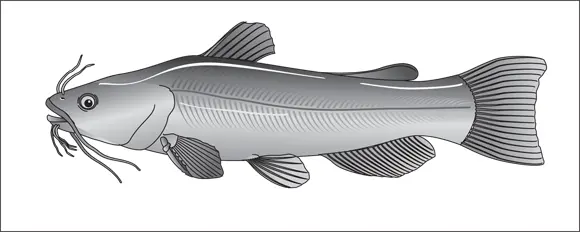
© John Wiley & Sons, Inc.
FIGURE 4-6:Bullheads aren’t big, but they sure are tough.
Like the sunfish family, the perches include several species popular with anglers. Two of the most popular are covered here, and they well represent the challenge and the great taste of this family. Yellow perch congregate in schools, can be readily caught, and are fine table fare. Walleyes taste great, too, but they also inspire anglers with their challenging habits. Like many species of fish, members of this family have been introduced beyond their native range, but it’s fair to say that the perch family tends to favor cooler, cleaner water, traditionally found in the northern part of the country.
Walleye: Popular like a largemouth, toothy like a pike
Walleyes are the largest members of the perch family, and like largemouth bass, they command a loyal following. Their excellent flavor may explain why walleyes are often the preferred fish where they are available. In Minnesota, you will often hear folks say, “Your can have your bass, and you can have your trout because the walleye is the best eatin' fish there is — bar none!” In addition to being delicious, they are found in schools, hang out around underwater structures, and usually locate themselves near drop-offs. Walleyes require a great deal of water and are rarely found in smaller lakes or ponds. Clear water and a rocky bottom are also high on its list of environmental preferences with water temperatures in the mid 60s (and never higher than the mid 70s) being optimum. It eats any baitfish available, and for that reason walleyes are often caught on minnows, although leeches and nightcrawlers work as well.
The walleye is a very light-sensitive fish, so although you may take one in shallow water, chances are that you will do this only in low-light conditions. Their eyes allow them to see well at night, and their prominent white eyes might be why some people insist on calling them “walleyed pike.” They’re not pike, though, so this is a misnomer.
As shown in the color section, the walleye is a torpedo-shaped fish with big eyes (hence wall-eye), a brownish-greenish color, and a white tip on the lower lobe of the tail. Walleyes could reach 25 pounds, but anything bigger than 6 to 8 pounds is a winner.
Yellow perch: Food for everyone
If walleyes share similarities with largemouth bass, yellow perch (as shown in the color section) have a lot in common with bluegills. Yellow perch are primarily lake fish, and they favor cool water with sand and rocky bottoms. They’re especially important and popular in the Great Lakes and Lake Erie in particular. Yellow perch have been stocked in lakes throughout the United States simply because they serve as great forage for predator fish and humans alike. Yellow perch grow slowly, so many of them end up as prey for fish such as walleyes and pike. But humans like the taste of perch just as much and target this fish with worms and minnows. Perch eat crustaceans and insects until they are large enough to consume minnows, and find protection from predators by forming schools. Any fish that schools could mean fast action for anglers; yellow perch can be caught year-round and are delicious to eat anytime. A torpedo-shaped fish like the walleye, yellow perch feature bands of yellow and green, and seldom get larger than 3 or 4 pounds, with the average well under that.
For flat-out mean looks, nothing in freshwater rivals the looks of a pike, pickerel, or muskellunge — all part of the pike family. A long fish with big eyes, a pointed snout, and rows of stiletto teeth, the average pike looks like what you might get if you crossed a snake, a bird, and a shark.
 When landing a pike, be extremely careful of its sharp teeth. They are about the nastiest thing in freshwater fishing. (This advice goes for the pike’s cousins, the muskie and pickerel.) As shown in Figure 4-7, the safest way to land a pike is with a landing net, and then grab the fish gently but firmly behind the gills.
When landing a pike, be extremely careful of its sharp teeth. They are about the nastiest thing in freshwater fishing. (This advice goes for the pike’s cousins, the muskie and pickerel.) As shown in Figure 4-7, the safest way to land a pike is with a landing net, and then grab the fish gently but firmly behind the gills.
Читать дальше
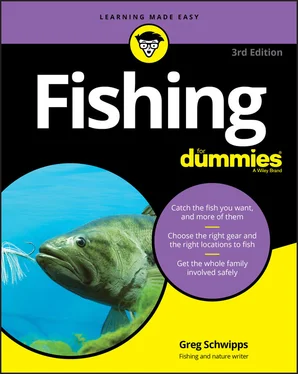




 When landing a pike, be extremely careful of its sharp teeth. They are about the nastiest thing in freshwater fishing. (This advice goes for the pike’s cousins, the muskie and pickerel.) As shown in Figure 4-7, the safest way to land a pike is with a landing net, and then grab the fish gently but firmly behind the gills.
When landing a pike, be extremely careful of its sharp teeth. They are about the nastiest thing in freshwater fishing. (This advice goes for the pike’s cousins, the muskie and pickerel.) As shown in Figure 4-7, the safest way to land a pike is with a landing net, and then grab the fish gently but firmly behind the gills.





